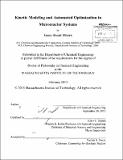| dc.description.abstract | The optimization, kinetic investigation, or scale-up of a reaction often requires significant time and materials. Silicon microreactor systems have been shown advantageous for studying chemical reactions due to their small volume, rapid mixing, tight temperature control, large range of operating conditions, and increased safety. The primary goal of this thesis is to expand the capabilities of automated microreactor systems to increase their scope and efficiency. An automated optimization platform is built utilizing continuous inline IR analysis at the reactor exit, and a Paal-Knorr reaction is chosen as the first example chemistry. This reaction, where both the first and second reaction steps affect the overall rate, leads to a more complex conversion profile. A steepest descent algorithm is first used to optimize conversion and production rates. The steepest descent algorithm tends to move slowly up the production rate ridge, significantly reducing efficiency. This issue is overcome by using a Fletcher-Reeves conjugate gradient method, which finds the constrained optimum in much fewer experiments. The conjugate gradient algorithm is then further improved upon by incorporating a hybrid Armijo line search and bisection contraction method. However, the conversion is only about 40% at the maximum in production rate. A further optimization is performed using a quadratic loss function to penalize conversions of less than 85%. This optimization of production rate led to an optimum at higher residence time, where a conversion of 81% is achieved. In the conventional view of reaction analysis, batch reactions are thought to be significantly more efficient in generating time-course reaction data than flow reactions, which are generally limited to steady-state studies. By taking advantage of the low dispersion in microreactors, successive fluid elements of the reactor may be treated as separate batch reactors. By continuously manipulating the reaction flow rate and tracking the total reaction time of each fluid element, time-course data analogous to that conventionally derived from batch reactors are generated and shown to be in agreement with steady-state results. Palladium-catalyzed carbonylation and CN-coupling reactions are used extensively in laboratory synthesis and industrial processes. The primary reaction studied involves the coupling of bromobenzene and morpholene with the addition of one or two carbonyl groups. The dependence of reaction conversion and selectivity on temperature, CO pressure, and Pd concentration are investigated using GC and IR analysis. A temperature ramp method is employed to rapidly investigate temperature effects on reaction rate and selectivity. The experiments reveal a change in the rate determining step at approximately 120 °C and corresponded well with GC data taken at several setpoints. In addition, the activation energy of the lower temperature regime as determined by this IR analysis is found to be very similar to that found by GC analysis, the experiments for which took significantly longer both to perform and analyze. Furthermore, the data collected from these experiments are used to fit a kinetic model. Multicomponent reactions (MCRs) are important to drug discovery by affording complex products in only a single step. By linking two of these MCRs, a Petasis boronic acid-Mannich reaction and an Ugi reaction, six different components could be incorporated in a relatively short time. The kinetics of each reaction are investigated with online UPLC analysis, allowing for quantification of a number of reaction components, including monitoring the formation of side products that were unknown prior to experimentation. A simple microcalorimeter is built using thermoelectric elements and a silicon microreactor to experimentally determine the heats of reaction during flow to allow for understanding the heat transfer needs for scale up. The result from the nitration of benzene, which has a heat of reaction of -117 kJ/mol, is -118.6 +/- 2.4 kJ/mol. The experimentally determined values are close to the known values; however, there is significant noise in the output during the reaction due to the two-phase nature of the reaction. The Paal-Knorr reaction is further investigated to determine the limits of sensitivity of the microcalorimetry system. A continuous concentration ramp experiment is performed with online IR analysis, enabling the thermoelectric output to be adjusted for reaction rate to determine the sensitivity to the heat of reaction. Below approximately 2 M, the sensitivity decreases rapidly, largely due to noise in the temperature control and concentration. To attempt to correct for the former, a calorimetry system with larger thermal mass is constructed and shown to decrease the sensitivity limit to 1 M, corresponding to a heat flow of approximately 0.05 W. | en_US |
